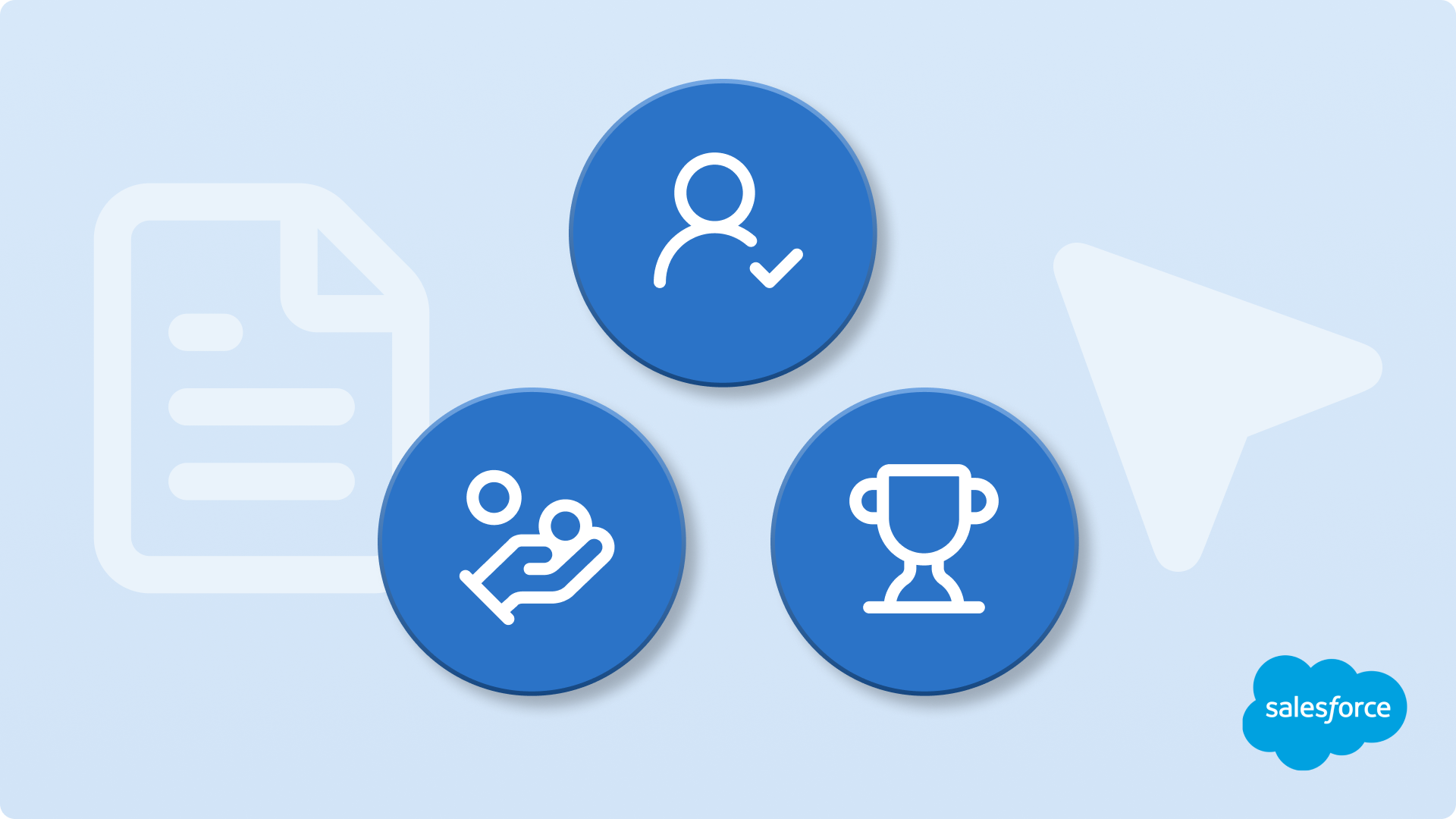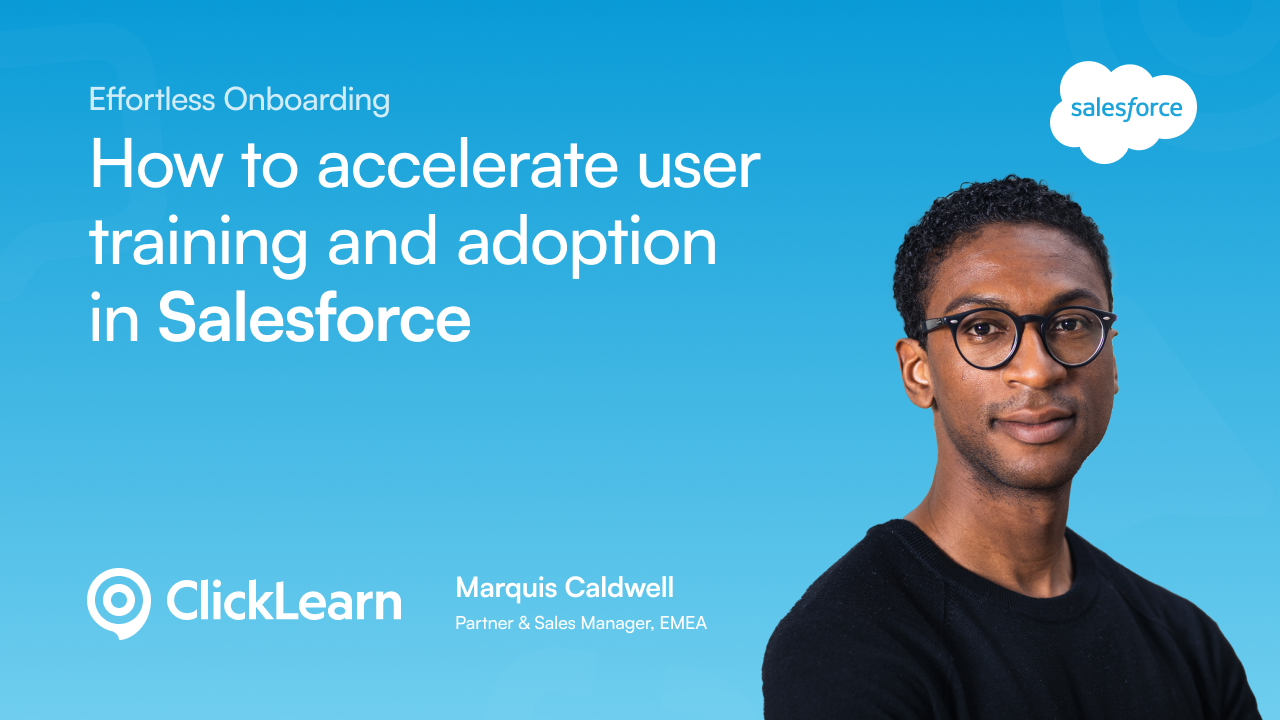Key Takeaways
Before implementing Salesforce, a robust user adoption strategy is essential to maximize ROI. Many employees utilize only about 50% of CRM functionalities, leading to low engagement, inconsistent processes, and missed opportunities. By establishing a structured adoption plan, organizations can enhance productivity, improve data quality, and fully leverage Salesforce's capabilities. Key strategies include securing leadership support, customizing user experiences, providing multi-format training, utilizing in-app guidance, fostering ongoing support, introducing gamification, and continuously measuring adoption metrics to refine the strategy.
Action Items
- Secure executive buy-in and define success metrics for Salesforce adoption.
- Tailor Salesforce configurations and training based on user roles and feedback.
- Provide role-specific, multi-format training content accessible on-demand.
- Implement in-app guided learning to support users during their workflow.
- Create centralized documentation and self-service help options within Salesforce.
- Foster community support and engage users through recognition and gamification.
- Regularly measure adoption metrics and gather user feedback to improve training and processes.
Why a user adoption strategy matters for Salesforce ROI
Before diving into tactics, it’s important to understand why a Salesforce adoption strategy is crucial. Salesforce’s broad feature set promises improved win rates and revenue – but only if users leverage those features. Studies show many employees use just 50% of CRM functionalities, leaving significant value untapped. Without a guided adoption plan, companies face:
Low engagement and resistance to change: Users often revert to old tools if they find Salesforce confusing or burdensome.
Inconsistent processes and data quality issues: Patchy adoption leads to incomplete data in Salesforce, undermining its effectiveness.
Missed ROI opportunities: Unutilized features mean the organization isn’t reaping the full benefits of its CRM investment.
By proactively addressing user adoption, IT leaders can ensure Salesforce becomes an integral part of users’ daily workflow. The payoff is tangible – higher productivity, better data for decision-making, and maximized ROI from Salesforce.
1. Align leadership and clear goals from day one
Secure executive buy-in and define success metrics at the outset. Enterprise-wide Salesforce adoption starts at the top – if leadership actively supports the CRM rollout, employees will follow. Leaders should communicate a clear vision of how Salesforce supports business objectives and set specific, measurable adoption goals (e.g. 100% of sales reps logging all opportunities in Salesforce). This alignment ensures everyone knows the “why” behind using Salesforce. As ClickLearn’s research notes, strong leadership involvement sends a message that the new system is mission-critical and worth embracing.
Tip: Have executives and managers champion Salesforce usage in meetings and status updates. For example, a sales VP can share wins achieved via Salesforce to reinforce its value.
Tip: Tie Salesforce usage to KPIs – for instance, make CRM data completeness part of performance reviews or sales comp plans. This creates gentle pressure and accountability (the “disadvantages to not using Salesforce”).
Enterprise IT teams should frame Salesforce as a solution to employees’ problems (faster quotes, fewer manual reports) rather than a top-down mandate. When leadership communicates benefits in terms of “what’s in it for the users” (WIIFM), it helps overcome resistance. By aligning Salesforce with both company goals and user needs, you lay the cultural groundwork for high adoption.
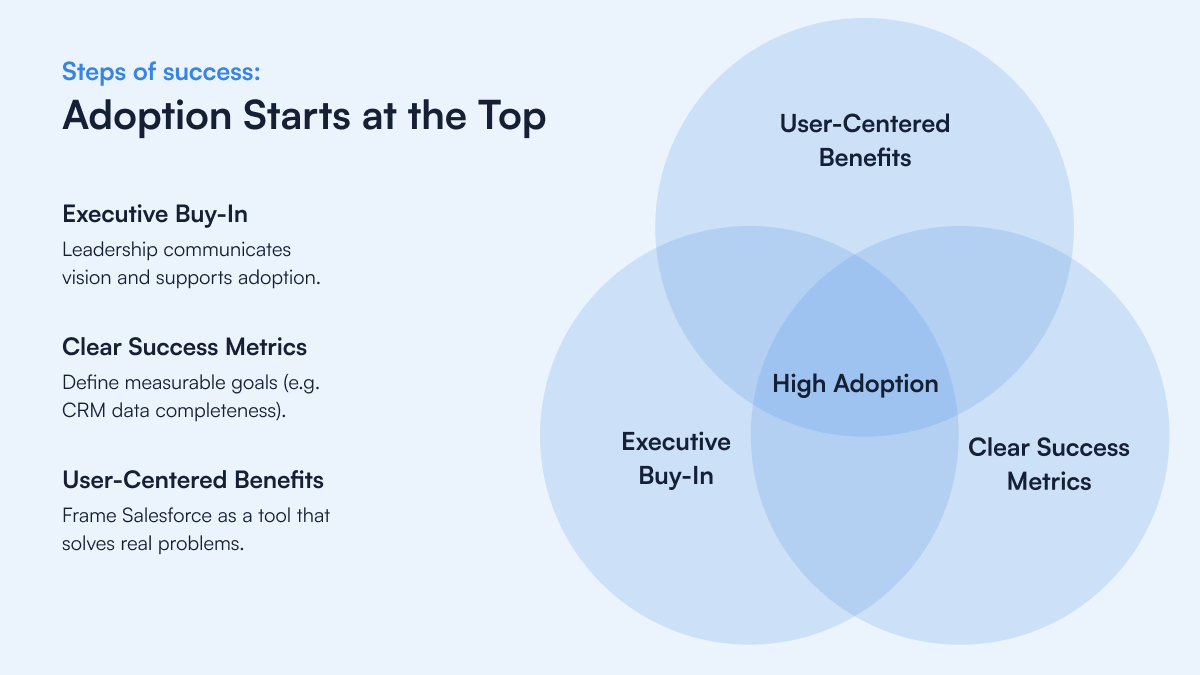
2. Understand users and tailor the experience
No two user groups use Salesforce exactly the same way. A key strategy is to take a user-centric approach: learn how different roles work and tailor Salesforce (and its training) accordingly. This involves:
Gathering end-user input during implementation – find out pain points, workflow needs, and common tasks for sales reps vs. managers vs. service teams. Then configure Salesforce to fit those workflows (custom fields, layouts, automations) so it feels intuitive.
Answering WIIFM (What’s In It For Me?): Clearly communicate to each user role how Salesforce will make their job easier (e.g. fewer manual spreadsheets, better customer visibility). Users are more likely to adopt when they see personal value.
Pilot testing with a small group: Do a Salesforce pilot rollout with a team of power users. Incorporate their feedback to fix usability issues or add helpful customizations before the full launch. This also creates internal champions who can evangelize the tool to peers.
User-centric design extends to training content. For example, a sales rep might need a quick-reference cheat sheet for logging sales opportunities, whereas a sales manager might need a dashboard training. By understanding these nuances, trainers can create more relevant, targeted guidance. ClickLearn makes this easier by allowing you to record real user processes and automatically turn them into personalized tutorials, ensuring training reflects actual day-to-day tasks. This customization of both the CRM and its training materials greatly reduces the learning curve and user frustration.
3. Provide role-based, multi-format training content
Effective training and onboarding is the backbone of Salesforce adoption. Enterprise trainers should design a program that is role-based and available in multiple formats to suit diverse learning preferences:
Role-specific training paths: Create separate learning tracks or modules for each department or role (e.g. Account Executive 101 vs. Sales Manager 101 in Salesforce). This ensures users aren’t overwhelmed with irrelevant features and can focus on mastering the functions that matter to their job.
Multi-format content delivery: Not everyone learns best from a lengthy manual. Some prefer watching a video demo; others may want step-by-step text instructions or even a hands-on sandbox exercise. Providing training in various formats – written guides, videos, slideshows, interactive walkthroughs – dramatically improves knowledge retention and accommodates all learning styles. With ClickLearn, trainers can record a Salesforce process once and automatically produce it as a video, PDF guide, PowerPoint, and more. This automated multi-format content generation saves countless hours for your L&D team and ensures every user can learn in their preferred way.
On-demand access: Host your Salesforce training content in a centralized repository or learning portal where users can access it anytime. This might include a searchable knowledge base, FAQ, or an internal LMS. ClickLearn provides a customizable eLearning portal out-of-the-box, meaning all those guides and videos you created are one click away for end users.
By investing in comprehensive training up front, enterprises set up their teams for success. Studies have found that thorough initial training combined with ongoing support leads to significantly higher CRM utilization. Users should feel confident about the basics after onboarding, and equally important, know where to find help when they need a refresher.
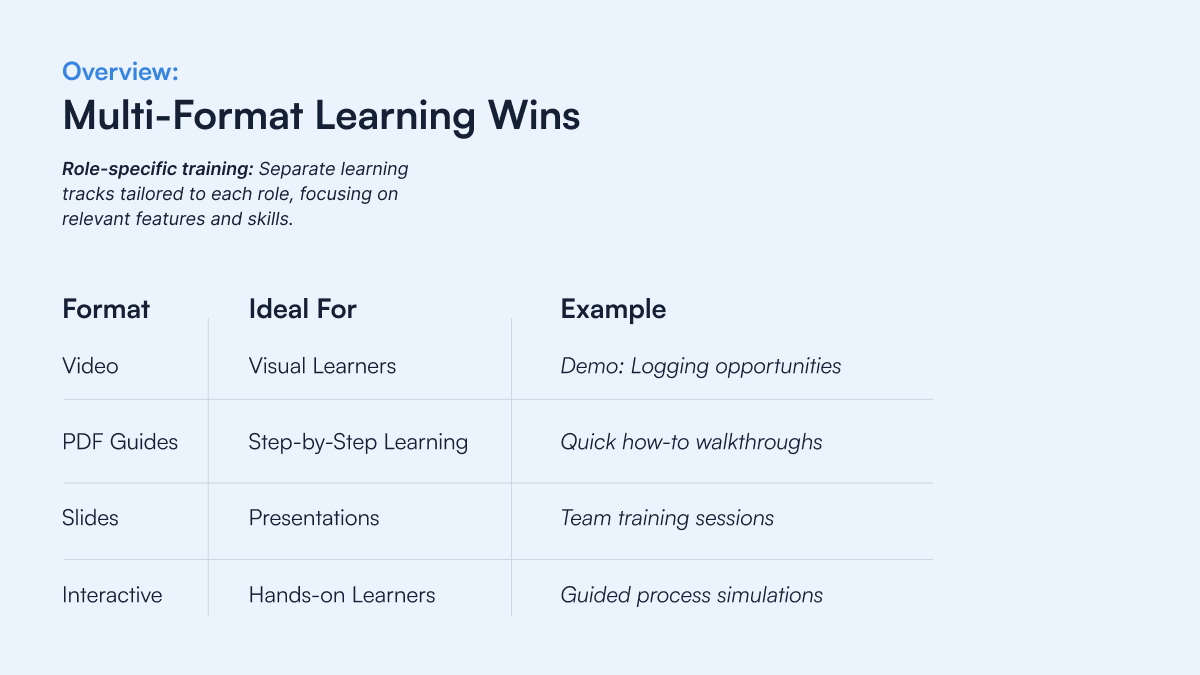
4. Drive onboarding with in-app guided learning
One of the most powerful adoption strategies is to bring the training inside Salesforce itself. Rather than pulling users off their workflow for classroom training or expecting them to memorize procedures, provide in-app guided learning that helps users as they work. Digital adoption solutions like ClickLearn excel here:
Interactive walkthroughs: These are step-by-step on-screen guides that pop up inside Salesforce to walk users through tasks in real time. For example, when a new sales rep first creates an Opportunity, a guided walkthrough can highlight where to click and what to enter at each step. This hands-on approach means users learn by doing, with Salesforce as the classroom. It significantly shortens the onboarding curve and builds confidence. In-app guidance has been shown to reduce training time and support needs – new employees can learn Salesforce “on the job” without intensive one-on-one coaching.
Contextual help and tooltips: Provide on-demand help within Salesforce pages. If a user is unsure how to fill a particular field or what a dashboard means, context-sensitive tooltips or a “Help” button linked to relevant documentation can instantly answer their question. This prevents frustration and keeps users in the flow of work.
Real-time assistance for accuracy: In-app guidance isn’t just about navigation; it can also improve data quality. For instance, ClickLearn (when used within Salesforce) can validate inputs and remind users of required steps. This real-time feedback loop ensures processes are followed correctly, reinforcing best practices. Salesforce admins often find that embedding such prompts leads to higher data accuracy and consistency.
A digital adoption platform like ClickLearn enables “guided learning in the flow of work” by integrating directly with Salesforce. It delivers pop-up instructions and help widgets right where users need them. The result: faster onboarding and proficiency. In fact, organizations using in-app training report onboarding times cut by as much as half and far fewer support tickets from new users. When users don’t have to leave Salesforce to learn, adoption feels natural rather than forced.
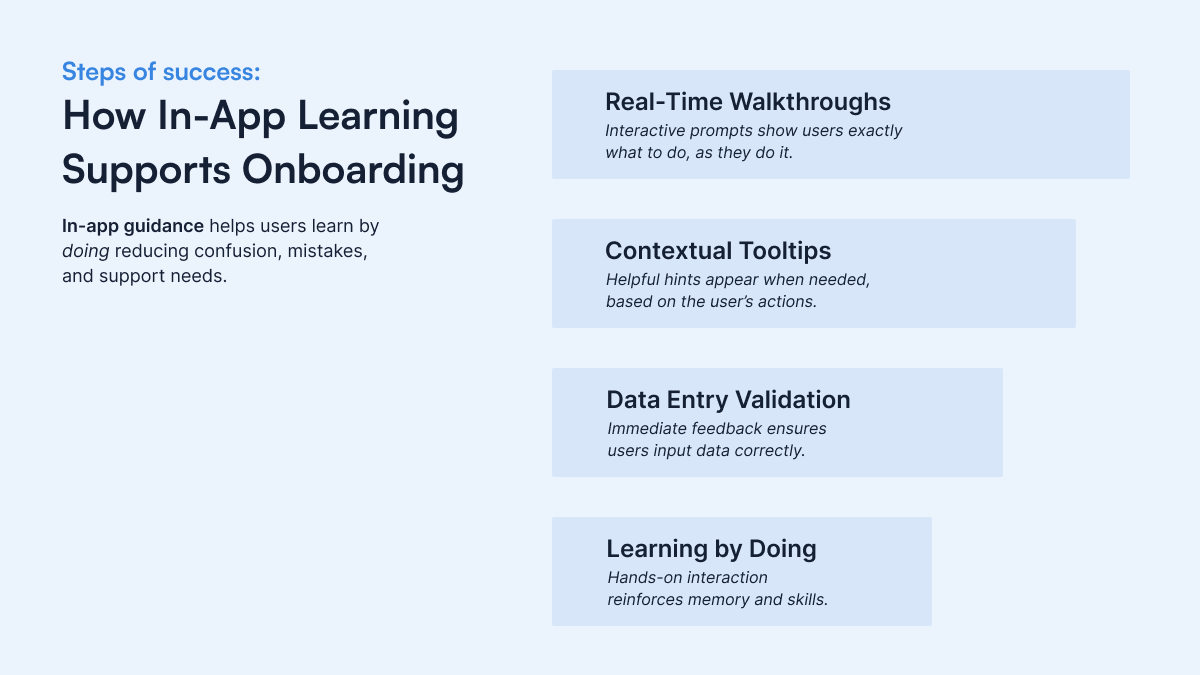
5. Create a continuous support and learning ecosystem
Training shouldn’t be a one-time event. To sustain Salesforce adoption in an enterprise setting, build an ecosystem of ongoing support where users can continuously learn and solve problems as they arise:
Centralized “single source of truth” documentation: All job aids, process docs, and tutorials should live in one accessible place (e.g. an intranet portal or knowledge base). Even better, integrate it with Salesforce or your intranet for easy access. Using ClickLearn, you can maintain up-to-date, centralized documentation that automatically updates when processes change. This prevents the common issue of outdated PDFs floating around. When users trust that the help materials are current, they’re more likely to seek them out rather than give up or go around the system.
Self-service help within the app: Leverage Salesforce’s AppExchange or browser extensions to embed a self-help widget. This widget can let users search FAQs, watch how-to videos, or read step-by-step articles without leaving Salesforce. By providing instant answers, you reduce support tickets and frustration – in fact, organizations have cut help desk calls by empowering users with in-app self-service content.
Community and peer support: Encourage the formation of user communities or Slack/Teams channels where staff can ask Salesforce questions and share tips. Salesforce’s own Trailblazer Community is a great resource; consider creating an internal “Salesforce champions” group as well. When users see colleagues actively discussing and solving issues, it normalizes asking for help and reinforces that Salesforce is a priority.
Dedicated office hours or coaching: In the early phases post-launch, have Salesforce experts (either internal super-users or consultants) hold regular Q&A sessions or office hours. Knowing that help is available if they get stuck gives users confidence to keep using the system rather than reverting to old habits.
ClickLearn’s 360° approach to user enablement supports continuous learning. Not only does it create the learning content, but it also provides an embedded training portal and in-app playback of tutorials on demand. This means a user stuck on a task can literally click “Help” and watch a short replay or step list recorded by ClickLearn showing exactly how to do that task, right in their Salesforce screen. By making help immediate and contextual, you maintain high adoption momentum even as time passes after go-live.
Emphasize how automated content updates keep the support ecosystem evergreen – e.g. when Salesforce issues a new UI update or your business process changes, you can re-record the process with ClickLearn and publish updated guides in minutes, so the support content never lags behind the software. This is a game-changer for enterprise trainers who otherwise struggle to continuously maintain documentation.
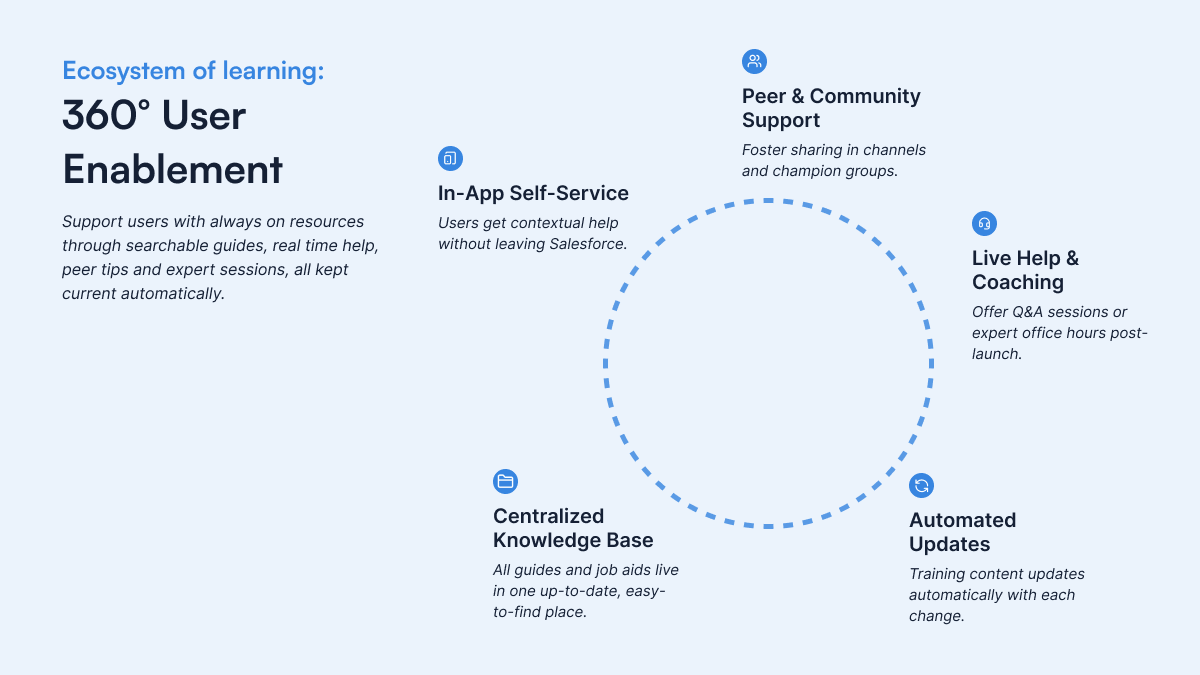
6. Foster engagement through incentives and gamification
Even with great training and support, you sometimes need to spark enthusiasm and sustain momentum. Enterprise teams have found success using incentives and gamification to drive Salesforce adoption:
Recognize and reward power users: Publicly celebrate individuals or teams who exemplify good Salesforce usage. For example, give monthly “Salesforce Champion” awards to those who consistently keep data updated or achieve high adoption metrics. Recognition taps into employees’ intrinsic motivation and makes adoption feel rewarding. This can be as simple as a shout-out in a town hall or as formal as part of performance bonuses (e.g. a small bonus for 100% CRM data hygiene).
Friendly competition: Introduce gamified elements like leaderboards or challenges. You might track activities such as number of opportunities entered, calls logged, or training modules completed in the first 90 days. Small prizes or team celebrations for the “winners” can inject fun into the adoption process. Salesforce even has native gamification apps (and many AppExchange solutions) to facilitate this. The key is to focus competition on behaviors that drive value, not just vanity metrics.
Badge and certification programs: Work with your L&D department to create an internal certification for Salesforce proficiency. As users complete training and demonstrate skills, award them badges or certificates. Not only does this acknowledge their effort, but it also signals to others that “if John earned his Salesforce Super User badge, maybe I should too.” This approach is particularly effective for large enterprises where career development and continuous learning are part of the culture.
By making Salesforce adoption part game, part goal, you transform what might feel like a tedious change into an engaging initiative. Just ensure any incentives align with quality usage (for example, reward accurate data entry and meaningful usage, not just high login counts). Gamification done right can substantially improve user adoption rates by building a sense of achievement and peer pressure in a positive way.
7. Measure adoption and continuously improve
Finally, treat Salesforce adoption as an ongoing, data-driven project. Enterprise IT teams and trainers should monitor key adoption metrics and gather feedback, then iterate on their strategy:
Track usage metrics: Leverage Salesforce’s tracking tools or your digital adoption platform’s analytics to measure things like login frequency, records created per user, feature utilization rates, time spent per task, etc. For example, track how many salespeople use the new quoting feature or how often support reps update cases in Salesforce. These metrics help identify where adoption is lagging – perhaps a certain department isn’t using Salesforce as expected, or a particular feature has low uptake.
Collect user feedback: Regularly survey or interview users about their experience. Are there obstacles preventing them from full adoption (slow performance, unclear processes, lack of understanding)? What features do they find most valuable, and which do they avoid? Frontline feedback can uncover training gaps or system pain points that data alone might miss.
Identify training or system adjustments: Use the data and feedback to act. If metrics show an advanced feature isn’t being used, maybe additional training or a refresher workshop is needed. If users complain a process in Salesforce has too many steps, perhaps you can simplify the workflow or provide a better guided tutorial for it. Adoption is a continuous improvement loop.
Update and enrich learning content: As processes change or new Salesforce features roll out (which is frequent with Salesforce’s updates), promptly update your training materials and in-app guidance. This is where having a tool like ClickLearn pays dividends – it allows you to quickly re-capture a process and automatically update all your learning content across formats. For instance, if a new Salesforce Lightning interface update changes a button location, you can re-record that in ClickLearn and publish new guides and walkthroughs in hours, ensuring users always have accurate instructions. Keeping content fresh signals to users that the organization is committed to their ongoing success.
By measuring and iterating, you keep the adoption strategy responsive. Over time, you’ll be able to correlate improved adoption with business outcomes (higher sales productivity, faster onboarding of new hires, fewer errors, etc.) – closing the loop to prove the ROI of your efforts. As Nucleus Research and others have noted, achieving high user adoption is the key to unlocking Salesforce’s full ROI potential.
Succeed in user adoption for your Salesforce users
Improving Salesforce user adoption in an enterprise isn’t a one-time checkbox – it’s an ongoing journey that blends change management, effective training, and the right digital tools.
By following these strategies – from securing leadership buy-in and tailoring training, to leveraging in-app guidance and continually iterating – your organization can turn Salesforce into a truly adopted, value-driving platform rather than “shelfware.” The result is sales and service teams that are more efficient, data-driven, and capable of delivering better customer experiences, ultimately maximizing the ROI of your Salesforce investment.
Ready to take your Salesforce adoption to the next level?
Explore how ClickLearn can support your Salesforce training and user adoption initiatives.
Request a demo or check out our latest eBook on Salesforce adoption strategies for a deeper dive. By combining a strong adoption strategy with ClickLearn’s innovative training platform, enterprise IT leaders can ensure their Salesforce rollout is not just used, but loved by every user.
